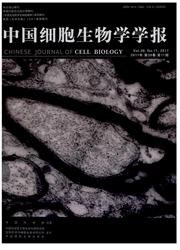

 中文摘要:
中文摘要:
在真核细胞中,内质网是蛋白质合成、折叠、加工及其质量监控的重要场所。当内质网难以承担蛋白折叠的高负荷时则引发内质网应激(ERstress),激活细胞的未折叠蛋白响应(unfoldedproteinresponse,UPR)。细胞通过内质网跨膜蛋白ATF6、PERK和IREl介导的三条极为关键的UPR信号通路,调控下游相关基因的表达,以增强内质网对蛋白折叠的处理能力。因此,UPR通路在细胞的稳态平衡中具有举足轻重的作用,而这一动态过程的调控对于维持机体的正常生理功能至关重要。近来大量研究表明,在哺乳动物中内质网应激与机体的营养感应和糖脂代谢的调控过程密切相关。在肝脏、脂肪、胰岛以及下丘脑等不同的组织器官中,内质网应激均影响代谢通路的调节机制,因此在糖脂代谢紊乱的发生发展中扮演重要的角色。综上所述,进一步深入了解内质网应激引发代谢异常的生理学机制,可以为肥胖、脂肪肝及2型糖尿病等相关代谢性疾病的防治提供新的潜在药物靶点和重要的理论线索。
 英文摘要:
英文摘要:
In eukaryotic cells, the endoplasmic reticulum (ER) is a crucial site for protein synthesis, fold- ing and quality control. Increased workload of protein folding during ER stress triggers the cellular unfolded protein response (UPR), and failure of the ER to adapt to ER stress leads to cellular dysfunction and apoptosis. The ER- localized transmembrane proteins ATF6, PERK and IRE1 mediate the three canonical branches of the UPR signal- ing pathways, which coordinately enhance the functional folding capacity of the ER to manage ER stress. Thus, the UPR is of central importance to cellular homeostasis and survival. Emerging evidence has shown that the UPR pathways are closely associated with cellular nutrient-sensing mechanisms as well as glucose and lipid metabolism. ER stress is found to affect key regulatory programs in metabolically active organs including the liver, adipose tis- sues, pancreatic islets and hypothalamus, and it is increasingly recognized as a critical player in the derangement of metabolic homeostasis. Thus, a better understanding of the pathogenic role of the ER stress pathways will offer novel targets for developing therapeutic leads against metabolic diseases such as obesity and type 2 diabetes.
 同期刊论文项目
同期刊论文项目
 同项目期刊论文
同项目期刊论文
 Association of PPP1R3B polymorphisms with blood lipid and C-reactive protein levels in a Chinese pop
Association of PPP1R3B polymorphisms with blood lipid and C-reactive protein levels in a Chinese pop Substituting White Rice with Brown Rice for 16 Weeks Does Not Substantially Affect Metabolic Risk Fa
Substituting White Rice with Brown Rice for 16 Weeks Does Not Substantially Affect Metabolic Risk Fa RACK1 modulates NF-kappaB activation by interfering with the interaction between TRAF2 and the IKK c
RACK1 modulates NF-kappaB activation by interfering with the interaction between TRAF2 and the IKK c Effects of flaxseed supplementation on erythrocyte fatty acids and multiple cardiometabolic biomarke
Effects of flaxseed supplementation on erythrocyte fatty acids and multiple cardiometabolic biomarke Interaction between a common variant in FADS1 and erythrocyte polyunsaturated fatty acids on lipid p
Interaction between a common variant in FADS1 and erythrocyte polyunsaturated fatty acids on lipid p Effects of Body Fat on the Associations of High-Molecular-Weight Adiponectin, Leptin and Soluble Lep
Effects of Body Fat on the Associations of High-Molecular-Weight Adiponectin, Leptin and Soluble Lep All-trans retinoic acid potentiates the chemotherapeutic effect of cisplatin by inducing differentia
All-trans retinoic acid potentiates the chemotherapeutic effect of cisplatin by inducing differentia High fat diet induces formation of spontaneous liposarcoma in mouse adipose tissue with overexpressi
High fat diet induces formation of spontaneous liposarcoma in mouse adipose tissue with overexpressi Critical Roles of p53 in Epithelial-Mesenchymal Transition and Metastasis of Hepatocellular Carcinom
Critical Roles of p53 in Epithelial-Mesenchymal Transition and Metastasis of Hepatocellular Carcinom PKA phosphorylation couples hepatic inositol-requiring enzyme 1 alpha to glucagon signaling in gluco
PKA phosphorylation couples hepatic inositol-requiring enzyme 1 alpha to glucagon signaling in gluco Associations of CFH Polymorphisms and CFHR1-CFHR3 Deletion with Blood Pressure and Hypertension in C
Associations of CFH Polymorphisms and CFHR1-CFHR3 Deletion with Blood Pressure and Hypertension in C The RAS Guanyl Nucleotide-releasing Protein RasGRP1 Is Involved in Lymphatic Development in Zebrafis
The RAS Guanyl Nucleotide-releasing Protein RasGRP1 Is Involved in Lymphatic Development in Zebrafis Fasting-induced protein phosphatase 1 regulatory subunit contributes to postprandial blood glucose h
Fasting-induced protein phosphatase 1 regulatory subunit contributes to postprandial blood glucose h Hepatic deletion of Smad7 in mouse leads to spontaneous liver dysfunction and aggravates alcoholic l
Hepatic deletion of Smad7 in mouse leads to spontaneous liver dysfunction and aggravates alcoholic l EphB3 Is Overexpressed in Non-Small-Cell Lung Cancer and Promotes Tumor Metastasis by Enhancing Cell
EphB3 Is Overexpressed in Non-Small-Cell Lung Cancer and Promotes Tumor Metastasis by Enhancing Cell Sorafenib Suppresses Postsurgical Recurrence and Metastasis of Hepatocellular Carcinoma in an Orthot
Sorafenib Suppresses Postsurgical Recurrence and Metastasis of Hepatocellular Carcinoma in an Orthot Associations of Amylin with Inflammatory Markers and Metabolic Syndrome in Apparently Healthy Chines
Associations of Amylin with Inflammatory Markers and Metabolic Syndrome in Apparently Healthy Chines Wld(S) Reduces Paraquat-Induced Cytotoxicity via SIRT1 in Non-Neuronal Cells by Attenuating the Depl
Wld(S) Reduces Paraquat-Induced Cytotoxicity via SIRT1 in Non-Neuronal Cells by Attenuating the Depl Associations of erythrocyte fatty acids in the de novo lipogenesis pathway with risk of metabolic sy
Associations of erythrocyte fatty acids in the de novo lipogenesis pathway with risk of metabolic sy Wld(S) Enhances Insulin Transcription and Secretion via a SIRT1-Dependent Pathway and Improves Gluco
Wld(S) Enhances Insulin Transcription and Secretion via a SIRT1-Dependent Pathway and Improves Gluco Associations of erythrocyte palmitoleic acid with adipokines, inflammatory markers, and metabolic sy
Associations of erythrocyte palmitoleic acid with adipokines, inflammatory markers, and metabolic sy Association between Common Variants in PPARD and Type 2 Diabetes and Modifying Effect of Vitamin D a
Association between Common Variants in PPARD and Type 2 Diabetes and Modifying Effect of Vitamin D a Association of TMPRSS6 polymorphisms with ferritin, hemoglobin, and type 2 diabetes risk in a Chines
Association of TMPRSS6 polymorphisms with ferritin, hemoglobin, and type 2 diabetes risk in a Chines Effects of a low-carbohydrate diet on weight loss and cardiometabolic profile in Chinese women: a ra
Effects of a low-carbohydrate diet on weight loss and cardiometabolic profile in Chinese women: a ra 期刊信息
期刊信息
